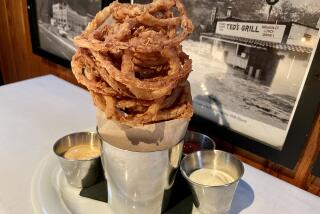From Symbol of Eternity to Food for Billions : For Centuries, Onions Made Good Scents
- Share via
GREELEY, Colo. — Long before Christ, it was a symbol of eternity fit only for the gods, an orb of fealty used to swear allegiance to Cleopatra, a farewell offering carved into Tutankhamen’s tomb.
Today, the onion is humble food consumed by billions. The pungent vegetable spices up our lives as a cheap, nutritious and tangy staple. Onions also are objects of modern medical research into everything from high blood pressure and cholesterol levels to why we cry tears and what those tears mean to our psyche.
‘Nutritional Wave’
Architecturally immortalized in the domes of the Kremlin and steeples of Russian Orthodox churches in Alaska, the common onion always has been bartered in the Third World. But it also is a valuable commodity in the marketplace of most of the industrialized nations, including the United States.
Today, the onion business is big in Texas, California, Idaho, Oregon, Colorado, Michigan and New York, as well as other states where farmers are struggling to find a profit in vegetables and lessen their dependence on soybean, corn and wheat crops.
“There’s a nutritional wave sweeping across this country, and onions are right in the middle of it,” says Frank Holder of Griffin-Holder Produce Co. in Rocky Ford, Colo., a pioneer in growing pearl onions in this country.
Growers claim that an onion can take the rust off a knife, keep frost off a windshield, clean gold leaf and suck paint odors out of a newly decorated room. But Holder and his 500 fellow members of the National Onion Assn., based in Greeley, are only the latest in a long line of historical cheerleaders.
Old wives’ tales, passed down for thousands of years, attribute aphrodisiac powers to onions. Legends claim that the tangy vegetable made soldiers brave and kept evil spirits at bay.
Onion growing was traced first to farmers in Iran and Pakistan 5,000 years ago. The Israelites, according to the Bible, craved them during their stay in the wilderness. Egyptian slaves were fed a ration of onions to give them strength to build the Pyramids.
In 1596, an English author took literary license in “The Greate Herbal” to claim that onion juice would make hair grow on bald heads. But the writer also claimed that onions could cure common colds and help the digestive system. Those two possibilities are still being researched.
For generations, the onion has had, in the words of the onion association’s public relations director, Sandy Lindblad Lee, “a bad rep.” For instance, there’s Shakespeare’s slur, written in 1593 in “The Taming of the Shrew.”
“Eat no onions nor garlic, for we are to utter sweet breath . . . “
Still, European kings accepted onions as wedding presents, pioneer women used their juices to dye lace and Britain’s Prince Charles still claims a ceremonial leek or two from his subjects in the Duchy of Cornwall.
Honored in Stamp
About 2 billion pounds of onions were grown in the United States last year, and Americans consumed an average of 11.4 pounds apiece. Even though that figure is up from the 9.8 pounds per capita tallied by the Agriculture Department in 1981, it is far below the estimated 30 pounds of onions eaten by everybody in Japan and the People’s Republic of China.
Frank Holder’s dedication to the onion may eventually pay off in the issuance of a U.S. postage stamp honoring the simple food that got its name from the Latin word “unio,” meaning many things in one.
“We’ve put everything from orchids to Presidents to writers to Santa Claus on our stamps, and it’s about time we paid homage to the crops which keep us alive,” Holder says.
Lee’s office is in Weld County, about 40 miles north of Denver in the heart of onion country. She says she eats onions every day. Part of her job is to bombard newspaper food editors across the country with new recipes using onions, which she tests in her own farmhouse kitchen.
Besides tracking medical experiments involving onions and promoting favorable findings, she also tramps around onion fields keeping track of crop yields and new farming techniques.
In 1983, about one-third of the 41,401 Colorado acres planted in vegetable crops (excluding potatoes) were dedicated to onions for a harvest worth more than $23.5 million to farmers. The 1984 crop is estimated at about $30 million.
Onion growers would like to expand their fairly meager export business, especially in Asia, says Marlene Monson, 30, a partner with her father, Joe, and brother, Ed, in Monson Brothers of Greeley.
But there are big risks as well as financial bonanzas across borders.
“Two years ago a storm hit Hokkaido and wiped out 70% of the Japanese crop,” Monson recalls. “The Japanese came here looking for onions and everybody got excited. We all turned our backs on our domestic market and started exporting, basically saying to our brokers, ‘We don’t need you guys.’
“The next year the whole industry paid for it with a glut--we all overplanted, the Asians didn’t buy, the crop was enormous and the prices were terrible. We sold onions for less than it cost us to raise them.”
More to Read
Eat your way across L.A.
Get our weekly Tasting Notes newsletter for reviews, news and more.
You may occasionally receive promotional content from the Los Angeles Times.









